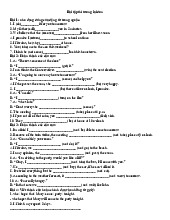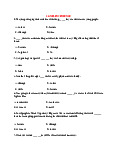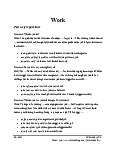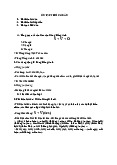


Preview text:
The Little Ice Age List of Headings
i Predicting climatic changes
A This book will provide a detailed examination of the Little
Ice Age and other climatic shifts (= change), but, before I
ii The relevance of the Little Ice Age today
embark on (bđầu) that, let me provide a historical context (bối
iii How cities contribute to climate change
cảnh). We tend to think of climate - as opposed to (khác vs, trái iv Human impact on the climate
với) weather - as something unchanging, yet humanity has been
at the mercy of (ko kiểm soát đc, phải phó mặc cho) climate
v How past climatic conditions can be determined
change for its entire existence, with at least eight glacial
episodes in the past 730,000 years. Our ancestors adapted to the vi A growing need for weather records
universal (phổ biến) but irregular (ko thường xuyên) global
vii A study covering a thousand years
warming since the end of the last great Ice Age, around 10,000
viii People have always responded to climate
years ago, with dazzling (chói sáng, kinh ngạc) opportunism change
(CN cơ hội). They developed strategies for surviving harsh ix Enough food at last
(khắc nghiệt) drought cycles, decades of heavy rainfall or
unaccustomed (bất thường) cold; adopted agriculture and stock-
raising, which revolutionised (cách mạng hóa) human life; and Questions 18-22
Complete the summary using the list of words, A—1,
founded the world's first pre-industrial civilisations in Egypt, below.
Mesopotamia and the Americas. But the price of sudden
Write the correct letter, A—I, in boxes 18-22 on your
climate change, in famine, disease and suffering, was often answer sheet. high.
Weather during the Little Ice Age
Documentation of past weather condition is limited: our
main sources of knowledge of conditions in the distant
B The Little Ice Age lasted from roughly 1300 until the middle past are 18 C and 19 B . We can deduce that the Little
of the nineteenth century. Only two centuries ago, Europe
Ice Age was a time of 20 A rather ,
than of consistent
freezing. Within it there were some periods of very cold
experienced a cycle of bitterly cold winters; mountain glaciers
winters, others of 21 H and heavy rain, and yet others
in the Swiss Alps were the lowest in recorded memory, and
that saw 22 G with no rain at all.
pack ice surrounded Iceland for much of the year. The climatic
A climatic shifts B ice cores C
events of the Little Ice Age did more than help shape the tree rings
modern world. They are the deeply important context for
D glaciers E interactions F weather observations
the current unprecedented (chưa từng có tiền lệ) global
G heat waves H storms I
warming. The Little Ice Age was far from (còn lâu) a deep written accounts
freeze, however; rather an irregular seesaw (tình trạng dao Questions 23-26
động) of rapid climatic shifts, few lasting more than a quarter-
Classify the following events as occurring during the
century, driven by complex and still little understood A Medieval Warm Period
interactions between the atmosphere and the ocean. The B Little Ice Age
seesaw brought cycles of intensely cold winters and easterly C Modem Warm Period
winds, then switched abruptly (thình lình) to years of heavy
Write the correct letter, A, B or C, in boxes 23-26 on
spring and early summer rains, mild winters, and frequent your answer sheet.
Atlantic storms, or to periods of droughts, light northeasterly
winds, and summer heat waves (đợt nắng nóng).
23 Many Europeans started farming abroad. C
24 The cutting down of trees began to affect the climate. C
C Reconstructing the climate changes of the past is extremely
25 Europeans discovered other lands.A
difficult, because systematic weather observations began only a 26 Changes took place in fishing patterns. B
few centuries ago, in Europe and North America. Records from
India and tropical Africa are even more recent. For the time
before records began, we have only 'proxy records'
reconstructed largely from tree rings and ice cores,
supplemented by a few incomplete written accounts. We now
have hundreds of tree-ring records from throughout the
northern hemisphere, and many from south of the equator (xích
đạo), too, amplified (khuếch đại) with a growing body of
temperature data from ice cores drilled in Antarctica,
Greenland, the Peruvian Andes, and other locations. We are
close to a knowledge of annual summer and winter temperature
variations over much of the northern hemisphere going back 600 years.
D This book is a narrative (chuyện kể, tường thuật) history of
climatic shifts during the past ten centuries, and some of the
ways in which people in Europe adapted to them. Part One
describes the Medieval Warm Period, roughly 900 to 1200.
During these three centuries, Norse voyagers from Northern
Europe explored northern seas, settled Greenland, and visited
North America. It was not a time of uniform (giống nhau, đồng
nhất) warmth, for then, as always since the Great Ice Age, there
were constant shifts in rainfall and temperature. Mean (trung
bình) European temperatures were about the same as today, perhaps slightly cooler.
E It is known that the Little Ice Age cooling began in
Greenland and the Arctic in about 1200. As the Arctic ice pack
spread southward (về hướng nam), Norse voyages to the west
were rerouted into the open Atlantic, then ended altogether.
Storminess increased in the North Atlantic and the North Sea.
Colder, much wetter (mưa) weather descended (= fall; affect)
on Europe between 1315 and 1319, when thousands perished in
a continent-wide famine. By 1400, the weather had become
decidedly more unpredictable and stormier, with sudden shifts
and lower temperatures that culminated (lên đến cực điểm) in
the cold decades of the late sixteenth century. Fish were a vital
commodity (hàng hóa) in growing towns and cities, where food
supplies were a constant concern. Dried cod (cá tuyết) and
herring (cá trích) were already the staples (mặt hàng chủ đạo)
of the European fish trade, but changes in water temperatures
forced fishing fleets (đoàn tàu) to work further offshore. The
Basques, Dutch, and English developed the first offshore (xa
khơi) fishing boats adapted to a colder and stormier Atlantic. A
gradual agricultural revolution in northern Europe stemmed
from (nảy sinh từ) concerns over food supplies at a time of
rising populations. The revolution involved intensive
commercial farming (thâm canh) and the growing of animal
fodder (cỏ khô) on land not previously used for crops. The
increased productivity from farmland made some countries
self-sufficient in grain and livestock and offered effective protection against famine.
F Global temperatures began to rise slowly after 1850, with the
beginning of the Modern Warm Period. There was a vast
migration from Europe by land-hungry farmers and others, to
which the famine caused by the Irish potato blight (bệnh tàn rụi
khoai tây) contributed, to North America, Australia, New
Zealand, and southern Africa. Millions of hectares of forest and
woodland fell before the newcomers' axes between 1850 and
1890, as intensive European farming methods expanded across the world. The unprecedented (khai hoang) land clearance
released vast quantities of carbon dioxide into the atmosphere,
triggering (gây ra) for the first time humanly caused global
warming. Temperatures climbed more rapidly in the twentieth
century as the use of fossil fuels proliferated (tăng nhanh) and
greenhouse gas levels continued to soar (tăng vụt). The rise has
been even steeper since the early 1980s. The Little Ice Age has
given way to a new climatic regime (chế độ), marked by
prolonged and steady warming. At the same time, extreme
weather events like Category 5 hurricanes are becoming more frequent.




